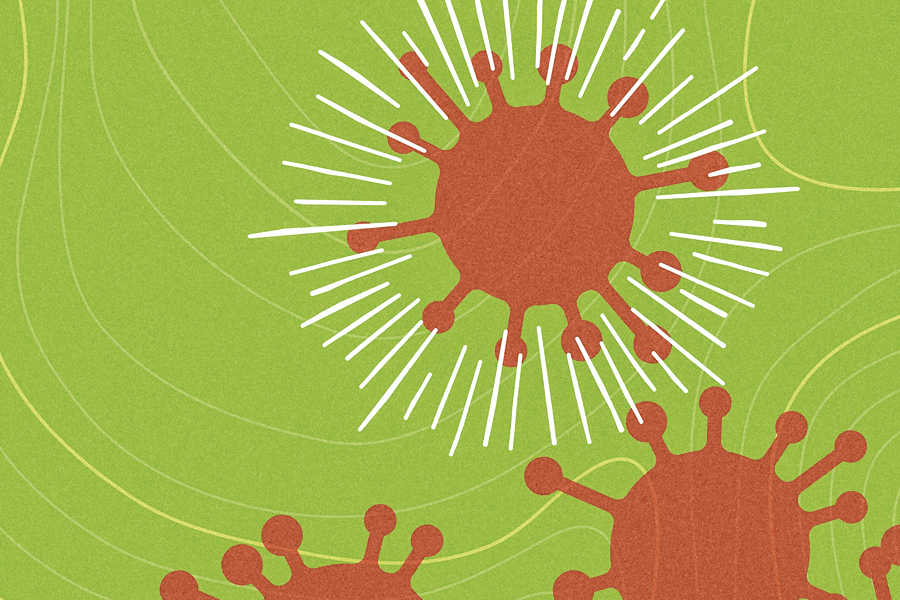
Translational Research at Penn Medicine is Speeding the Battle Against COVID-19
By Melissa Moody
COVID-19 is not just a virus. The clinical disease caused by the novel coronavirus, SARS-CoV-2, is the result of a complex and ongoing battle within the body between the invading virus and the body’s defense system.
“The immune system is going to be involved in all COVID-19 infections that we see in patients, in fighting the infection, in the resolution of the infection, and in what protects us in the future,” said E. John Wherry, PhD, chair of Systems Pharmacology and Translational Therapeutics and director of the Institute for Immunology at the Perelman School of Medicine. “The immune system evolved over hundreds of millions of years to do exactly this—to balance protection versus tissue damage. And it gets it right quite a lot of the time. But it also gets it wrong, sometimes making things worse or failing to control the infection, especially when it’s a virus new to our system.”
Timing Matters
Timing really matters when it comes to infections like COVID-19, Wherry said.
The virus enters the nose or mouth to infect the lung cells, where it can replicate fast. For a tactical victory, all the virus has to do is delay the immune response by a couple of days, and from 100 infected lung cells on day one, tens of millions are conquered four or five days later.
Timing also matters in a pandemic. And Penn’s immunology group was able to get their research off the ground incredibly quickly. Less than a half hour after landing at Philadelphia International Airport March 18 on his way home from a conference, Wherry was on the phone with his friend and colleague Michael Betts, PhD, to talk about the SARS-CoV-2 virus and the disease it causes, COVID-19. At that moment, Betts, a professor of Microbiology and viral immunologist at Penn, was walking out of a school board meeting in his children’s district, where he’d warned that the virus was a serious concern.
And following that phone call, Wherry and Betts would both be venturing in new research directions.
Wherry’s research typically focuses on the immune response of patients with cancer and chronic infections, with a goal of understanding overall immune health and developing personalized, targeted therapeutics. Betts’ work revolves around the human immune response to viral pathogens, mainly HIV.
Now Wherry and Betts set out to investigate how patients’ immune systems were responding to COVID-19. The pair hoped to inform potentially life-saving treatments to a disease that at that point had none, by understanding the battle that wages within the body between a virus and the immune system’s response.
After a virus invades, the innate immune system responds first, detecting a foreign invader and creating antibodies. But if a virus subverts these early defenses, the body next needs to deploy its special operations forces that have been trained through past experiences (if they’ve had any) to fight the specific invader that the body is facing—the T cells.
But every step of this battle can ravage the body in its way. COVID-19 disease becomes severe when viruses evade the innate immune system and replicate in the lungs. T cells can help fight the disease. But if that battle rages too large, the fortress of your body can suffer as much from the havoc wreaked by your own troops as from the infection itself.
Basic Science on the Clinical Front Lines
When the pandemic hit, Nuala Meyer, MD, an associate professor of Pulmonary, Allergy and Critical Care, was working with COVID-19 patients in the hospital. And she, too, took a well-timed call from John Wherry.
Meyer’s translational research has focused on understanding how a patient’s body responds to infections and finding novel treatments. When she got Wherry’s call, that research accelerated. Their daily phone calls to discuss COVID data marked an exchange between basic scientists and clinicians that was almost unheard of prior to the pandemic.
“I had a patient whose particular circumstances made us question whether he would mount a strong immune response or not,” Meyer said. She wanted to know if a therapy that would attack a specific part of the immune system would be the right choice.
Wherry and Betts’ teams came in on a weekend and had results telling Meyer what was happening in the patient’s immune system in just ten hours. Normally, she said, the time from enrolling a patient in a study to getting data back to use at the bedside would be from six months to two years.
“Our research is having a direct effect on how patients are being treated, Betts said, “almost in real time.”
The Future Fight
There are a number of really big questions still open that Wherry, Betts, and others at Penn are investigating, Wherry said, including how immune people remain after infection.
Immunologists are increasingly examining how T cells learn to fight the virus effectively but not overzealously. “One big area that we're focused on trying to understand is the formation and quality of T cell memory,” Wherry said.
Wherry is also looking at the immune system in COVID-19 patients with long-term symptoms, the relationship of the immune system to vascular problems, and how previous infections might impact our immune response to the virus.
Betts’ lab is pursuing how immunity develops in those with milder infections, how long-term protective immunity differs over time, and the implications of those answers for the development of vaccines.
And the collaborative and multidisciplinary push in Penn’s immunology community continues.
“This is the first time I’ve ever seen a cohesive, unanimous response to a scientific charge,” Wherry said. “We’ve gained expertise through these studies that have changed the landscape of what kinds of things we can do in human immunology really quickly in collaboration with clinicians.